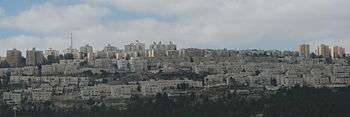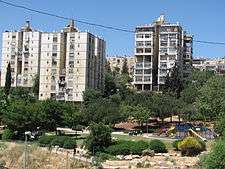Neve Yaakov
Coordinates: 31°50′28″N 35°14′33″E / 31.84111°N 35.24250°E

Neve Yaakov also Neve Ya'aqov, (Hebrew: נווה יעקב) (lit. Jacob's Oasis), is an Israeli settlement[1] and neighborhood[2] located in East Jerusalem,[3][4][5][6][7] north of Pisgat Ze'ev and south of al-Ram. Established in 1924 during the period of the British Mandate, it was depopulated during the 1948 Arab-Israeli War. The area was captured by Israel in the Six Day War and a new neighborhood was built there, at which time international opposition to its legitimacy began.[8] The international community considers Israeli settlements in East Jerusalem illegal under international law, but the Israeli government disputes this,[9] defining it as a neighborhood within the jurisdiction of the Jerusalem Municipality, which provides all services.[10] The population of Neve Yaakov is 30,000. Neve Yaakov is one of Jerusalem's Ring Neighborhoods.[11]
History


Neve Yaakov was established in 1924 on a 65 dunams (0.065 km2; 0.025 sq mi)[12] parcel of land purchased from the Arabs of Beit Hanina by members of the American Mizrachi movement.[13] HaKfar HaIvri Neve Yaakov (The Jewish Village of Neve Yaakov) was named for the leader of the movement, Rabbi Yitzchak Yaacov Reines (1839–1915).[14] It was an hour's walk to the Old City, where most Jews of Jerusalem lived at the time. Until they were abandoned in 1948, Neve Yaakov and Atarot were the only Jewish settlements north of the Old City.[13]
The first houses were ready for occupancy in Av (summer) 1925. The village's rav, Rabbi Yitzchak Avigdor Orenstein, ruled that new homeowners could move into their homes even during The Nine Days, saying that the mitzvah of settling the Land of Israel overrode the laws of the mourning period. Rabbi Orenstein himself moved into his new house during The Nine Days, while village administrator Dov Brinker moved his furniture and belongings into his new house on Tisha B'Av itself.[12]
The village, home to 150 families, suffered from financial problems and lack of a regular water supply. After years of hauling water in buckets from a well six kilometers away, the village received a government water pipeline in 1935. Electricity was hooked up in 1939.[13]
After years of peaceful co-existence with the surrounding Arab villagers, from whom they purchased vegetables, fruit and eggs, the inhabitants of Neve Yaakov were attacked during the 1929 Palestine riots, and many families returned to the Old City. According to a census conducted in 1931 by the British Mandate authorities, Neve Yaakov had a population of 101 inhabitants, in 20 houses.[15] In the course of the 1936–39 Arab revolt in Palestine, shots were heard from the Arab side almost every night. The British Mandate government supplied a cache of arms to defend Neve Yaakov, and members of the Zionist Haganah pre-state army moved in to guard the village and its water pipeline.[13]
During the peaceful years from 1940 to 1947, the village operated a school that accepted students from all over the country. Children's summer camps and convalescent facilities were opened, taking advantage of the rural atmosphere and fresh air. Veteran Jerusalem residents remember hiking to Neve Yaakov to buy fresh milk from dairy farmers.[13]
When the Jordanian Arab Legion advanced toward Jerusalem from the north during the 1948 Arab–Israeli War, Neve Yaakov and Atarot were abandoned in the wake of advance warning that they were about to be attacked.[16]<[17] Atarot was abandoned on May 17, 1948.[17] The region was occupied by the Jordanians until the 1967 Six-Day War, when Israel captured the Old City and environs.[13]
Re-establishment of Neve Yaakov
In August 1970 3,500 acres of privately owned and titled Palestinian land was confiscated for "public purposes". On this land 4 residential colonies were established including Neve Yaakov with 4,000 apartments.[18] In 1972, a new Jewish neighborhood was constructed on the site of the original village, with 4,900 apartments in high-rise buildings.[13] The new neighborhood was populated by Jewish immigrants from Bukhara, Georgia, Latin America, North Africa, France and Iran. In the 1990s, when large waves of Russian and Ethiopian Jews came to Israel, many settled in Neve Yaakov.[13]
In October 1971, Rabbi Meir Kahane presented the Minister of Immigrant Absorption, Natan Peled, a memo detailing plans for a community for American Jews in Neve Yaakov.[19]
Kiryat Kaminetz
In 1982, Kiryat Kaminetz, a housing development on the eastern edge of Neve Yaakov named for the Jewish community of Kamenets, Poland destroyed in the Holocaust, was built on the eastern side of the existing neighborhood. Several hundred apartments were populated by young, Haredi Jewish families, many of them from English-speaking countries. In 1992, 700 new apartments were added to Kiryat Kaminetz on the eastern slope of the mountain; this new neighborhood is also known as Neve Yaakov Mizrach (Neve Yaakov East). The latter has a high concentration of Hasidic and Sephardic Haredi families, with a variety of schools and synagogues serving each population. Neve Yaakov Mizrach is also home to two yeshivas catering to American students: Yeshivas Bais Yisroel and Yeshivas Lev Aryeh.[13]
The Haredi character of the neighborhood has expanded further since 2004 with an influx of newlywed couples, both Israeli-born and immigrants originating from English-speaking countries, to the older sections of Neve Yaakov. This new trend has been characterized by calling the older section the Mitchared (literally, "Haredization") In 2009 the Haredi presence in Neve Yaakov was estimated at 900 families.[20]
Figures as of January 2016 from the Jerusalem Municipality showed a total population of 24,225, of which nearly half are under the age of 21. Seventy-six percent of the population is under the age of 40.[21] Neve Yaakov is noted as having the largest kindergarten enrollment in the city. The 2016 figures cite 91 percent as being enrolled in Haredi kindergartens. In the elementary school system, 86 percent of children are enrolled in Haredi schools.[21]
References
- ↑ "'We were looking for a nice, peaceful place near Jerusalem'". The Guardian. Retrieved 29 November 2013.
- ↑ Siddique, Haroon (10 March 2008). "Israel suspends Gaza air strikes". The Guardian. London.
- ↑ Shabi, Rachel. 'We were looking for a nice, peaceful place near Jerusalem' The Guardian. 24 September 2010
- ↑ Bronner, Ethan. Israel Objects to U.S. Construction Demands New York Times. 16 March 2010.
- ↑ Israel plans to build more homes in E Jerusalem BBC News. 28 December 2009
- ↑ Rebhun (2001). "The Demographic Dimension in Conflict Resolution: The Case of Jerusalem" (PDF). Mediterranean Quarterly (12): 80–89.
- ↑ Sela, Neta. Residents: Arab school will endanger us Ynet, 02.20.06
- ↑ Phillips, Leigh (29 December 2009). "Israeli Settlement Construction in East Jerusalem Draws EU Rebuke". EU Observer. Retrieved 25 April 2011.
- ↑ "The Geneva Convention". BBC. 10 December 2009. Retrieved 27 November 2010.
- ↑ "Municipal Services in Jerusalem – Network of Services". Israel Ministry of Foreign Affairs. 25 August 1999. Retrieved 25 April 2011.
- ↑ "Israel and Palestine" (155–162). 1990: xxxi.
- 1 2 Shpinner, Yossi (29 July 2011). כפר עברי ראשון בהרי ירושלים [Kfar Ivri, The First in the Jerusalem Hills]. Makor Rishon (in Hebrew). Retrieved 7 May 2012.
- 1 2 3 4 5 6 7 8 9 Hall, J. How "HaKfar HaIvri" Became "Rechov Kfar Ivri". Shiras Devorah: Neshei Neve Yaakov newsletter for English-speaking women, Vol. 1, No. 4, Kislev 5759 (December 1998), pp. 15-17.
- ↑ "Rav Jacob Reines (1839–1915)". World Mizrachi Movement. 2001. Retrieved 25 April 2011.
- ↑ Mills, 1932, p. 42
- ↑ "American Newlyweds in Israel, 1948". American Jewish Historical Society. 11 April 2011. Retrieved 25 April 2011.
- 1 2 >Encyclopedia Judaica (2008), Atarot, via Jewish Virtual Library
- ↑ Mattar, Ibrahim (Summer 1983). "From Palestinian to Israeli: Jerusalem 1948-1982". Journal of Palestine Studies. 12 (4): 57–63. doi:10.2307/2536245. JSTOR 2536245.
- ↑ Kahane, Libby (2008). Rabbi Meir Kahane: His Life and Thought Volume One 1932-1975. Israel: Urim Publishers. p. 229. ISBN 965-524-008-8.
- ↑ Spira, Yechiel (3 May 2009). "N'vei Yaakov's Rolling Shul a Possible Solution". Yeshiva World News. Retrieved 24 May 2009.
- 1 2 "שכונת נווה יעקב" [Neve Yaakov Neighborhood] (in Hebrew). Jerusalem Municipality. 2016. Retrieved 21 May 2016.
External links
- Nefesh B'Nefesh Community Guide for Neve Yaakov, Jerusalem, Israel
- Go Jerusalem.com guide of Neve Yaakov, Jerusalem, Israel
- Photos of Neve Yaakov, Jerusalem, Israel
| Wikimedia Commons has media related to Neve Yaakov. |
